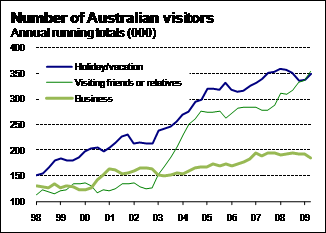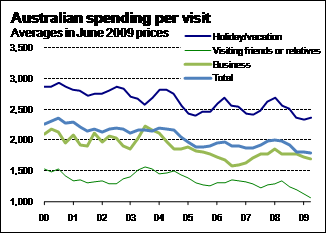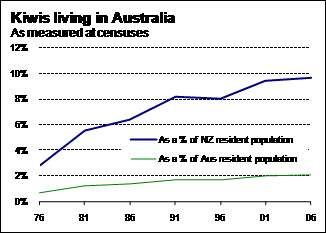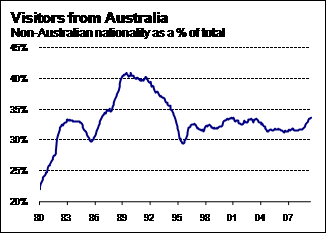Across the ditch
During a time when the tourism sector has been struggling, Statistics NZ data shows that the number of visitor arrivals from Australia topped one million in the year to May 2009 for the first time. Although this milestone is a great one to have reached, the sheer number of people coming across the border isn’t the only factor that affects our economy’s tourism earnings – the make-up of those visitors is also important. Over the last decade, the make-up of those visitors has changed, and as far as our economy is concerned, this change has not been a beneficial one.
Australians offer the least
In comparison to other nationalities, Australians offer the least benefit to the New Zealand economy per visitor. In the year to June 2009, the average expenditure of a visitor from Australia was $1,793. Of the ten most common nationalities for visitors to New Zealand, this figure places Australians as the lowest spenders, spending 30% less than the next most frugal tourists, from Singapore. Over the year to June 2009, one Japanese visitor spent the same amount as 2.8 Australian visitors. This gap is largely due to Australian visitors staying for a shorter period of time than any other nationality because of the close proximity of the two countries.
New Zealand’s ties with Australia have also strengthened, and with increased competition resulting in cheaper airfares across the Tasman, excursions to New Zealand are becoming more accessible for Australians. The high number of acquaintances that Australians and New Zealanders share means that Australians can rely on the hospitality of family and friends here in New Zealand, reducing their expenditure.
The wrong purpose
According to the International Visitor Survey (IVS), the number of Australian visitors to New Zealand increased by 102% over the decade to June 20091. Over the same period, total expenditure by Australian visitors increased by only 64%. So while the number of Australian visitors has increased, the average expenditure per visitor has declined, dampening the positive effect that the increase in Australian visitors has on our domestic economy.

Graph 1.1
The underlying reason for the decline in average expenditure by Australians is due to the change in the make-up of Australian visitors. In the year to September 2002, 24% of all visitors from Australia came to visit family and friends. In the year to June 2009, the proportion of Australian visitors who came to visit family and friends had risen to 39%. This growth is shown clearly in Graph 1.1. The year to June 2009 was the first time on record that the number of people here to see family and friends was the greatest source of arrivals from Australia, outstripping the number of Australians who came for a holiday.

Graph 1.2
At the end of 2002, before the number of people from Australia visiting friends and relatives started to grow rapidly, the average expenditure per night was $188 in today’s prices. This figure fell to $143 per night for the year to June 2009. Average expenditure for the whole stay declined from $2,184 to $1,793 over this period (June 2009 prices). So despite the number of visitors increasing, the marginal benefit for the New Zealand economy from an Australian visitor has decreased by 18% over the last seven years.
Aussies or Kiwis?
Over the last few years there has been a large increase in the flow of visitors to New Zealand from Australia, spurred by the reduction in airfare costs. However, it has been the number of those coming to visit friends or relatives that have seen the most dramatic growth in the last decade. Average expenditure in all "purpose of visit" categories has declined since June 1999. But the higher proportion of visitors coming to see their acquaintances has helped reduce the average expenditure of a visitor from Australia, dampening the positive effect on our economy of the lift in Australian visitor numbers.
One possible explanation for the increase in the number of people visiting friends and relatives is the growing number of New Zealanders living in Australia. Census data since 1976 shows that the number of New Zealand-born people living in Australia has risen from under 90,000 to almost390,000 over the last 30 years (averaging 5%pa growth over that period). This growth corresponds with a 5.2%pa increase in the number of "Australian" visitors coming to New Zealand between 1979 and 2009. The increasing number of New Zealanders in Australia, as a proportion of both Australia’s and New Zealand’s resident populations, is shown in Graph 1.3.

Graph 1.3
Figures on the nationality of Australian-resident tourists are not readily available beyond "Australian" and "other" categories. But, surprisingly, Graph 1.4 shows that the proportion of visitors from Australia identifying themselves as being not of Australian nationality has held steady at 30-35% since the mid-1990s.

Graph 1.4
Nevertheless, it is our view that the increasing number of Kiwis living across the Tasman has played a significant role in affecting the make-up of visitors coming from Australia, and has thus affected spending patterns. The strong migration flow to Australia since 2005 appears to be linked to the increase in the number of people visiting friends and relatives since 2007. We would expect this lift in the number of people visiting friends and relatives to be maintained going forward.
1Data from the IVS paints a different picture of the arrival numbers to data from arrival and departure cards. We believe the arrival and departure card numbers provide a better indicator of visitor numbers, but for the purpose of understanding trends in visitor spending, we have chosen to use the IVS data.






